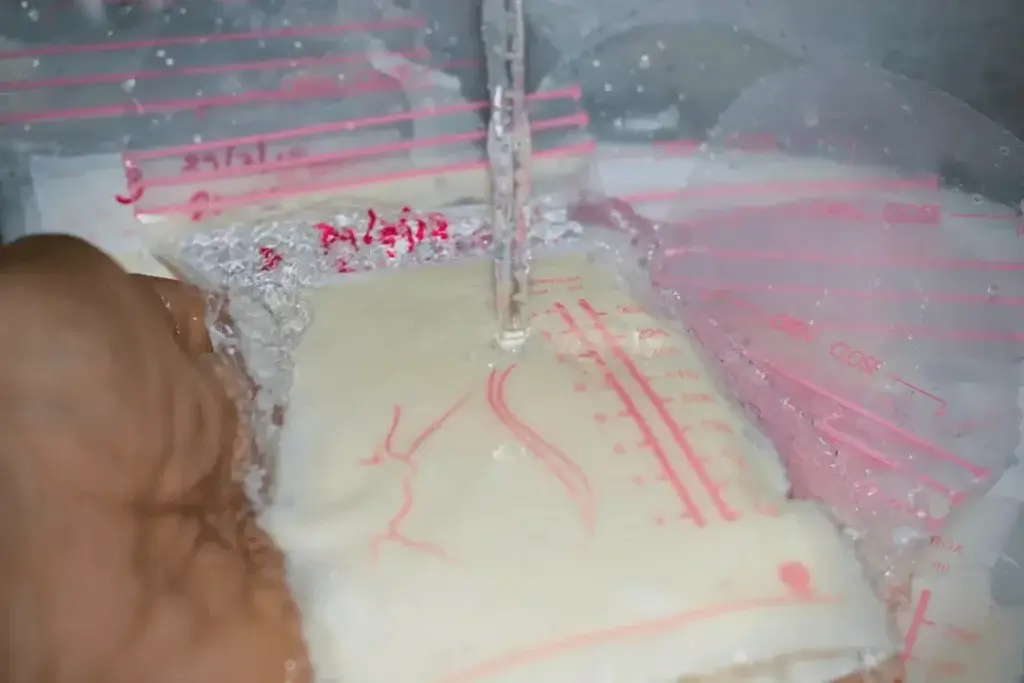You can save a lot of money on milk by looking for bulk discounts at the grocery store and purchasing a dozen cartons of your preferred brand and kind of milk when it is on sale for such a low price that you cannot pass it up. This is a terrific way to save money.
The problem is that milk is a perishable product, which means that it goes bad in a short amount of time. Even if it is not opened, raw milk has a shelf life of about 5-7 days when it is not pasteurized. On the other hand, UHT milk has a shelf life of one to two months when stored in the refrigerator.
When time is of the essence, it’s helpful to have milk stashed away in the freezer. If you took advantage of a bargain on milk or intended to store it in case of an emergency, you must know how to thaw the milk properly. As long as you allow yourself enough time, defrosting milk is a very hands-off process, which is fortunate.
Table of Contents
How Do I Let the Milk Defrost?
Milk may be safely defrosted in one of two ways: either by transferring it from the freezer to the refrigerator and allowing it to sit there for the duration of the night or by thawing it for a shorter period in cold water.
After the milk has been allowed to thaw using the technique of your choice, be sure to give the milk container a thorough shake before using it. When milk is frozen, the milk fat and solids tend to separate, but shaking the container well can help you combine them again.
You’re undoubtedly curious why we haven’t included the microwave on our list. Let’s say the “Defrost” setting on your microwave is not the most effective method for defrosting milk, right? The grounds for this decision will be discussed in just a bit.
Method 1: Defrosting Milk in the Fridge

Putting frozen milk in the refrigerator allows it to defrost at a temperature that is below 40 degrees Fahrenheit (4 degrees Celsius), which eliminates the risk of the milk being spoiled.
In addition, this defrosting method is about as easy as it gets when it comes to defrosting methods: all you have to do is remove the milk carton from the freezer, place it in the refrigerator, and let it defrost for between twenty-four and forty-eight hours. And voilà, you have drunk milk!
You do not need to worry about milk spillage if it was frozen in its original packaging before being frozen again. On the other hand, milk that has been frozen in freezer bags has to be placed in a bowl in the refrigerator once it has been frozen.
It takes some time for milk to defrost in the refrigerator after being frozen. Expect it to take between seven and eight hours for a small bag in the freezer or carton to thaw out. It might take twenty-four and forty-eight hours for a gallon jug of frozen milk to thaw entirely.
It is recommended to remove the milk from the freezer at least two days before you will need it because it might take the milk quite some time to thaw out in the refrigerator. This provides the milk the time it needs to defrost properly and eliminates the need to resort to less safe alternatives, such as using the microwave.
Method 2: Thawing Milk in Cold Water

You also have the option of defrosting your frozen milk by placing it in a sink that is filled with cold water. To defrost milk contained in smaller containers, you might alternatively use a big pot or basin filled with cold water. If you need your milk to thaw more quickly, or if you don’t have room in the refrigerator right now, this is an excellent alternative for you to consider.
The water in the sink must be kept at a frosty temperature so the milk may be stored without risk. Without proper sanitation, bacteria will begin to consume the milk and then reproduce inside it, hastening the process by which the milk goes bad and rendering it unfit for human consumption.
Every thirty minutes, take a reading of the temperature of the water. If the water is starting to grow warm, you should drain it all out and fill it back up with cold water. The process of defrosting milk in cold water is quicker than defrosting it in the refrigerator, although defrosting milk in cold water might still take a few hours based on the scale of the container.
How Should a Gallon of Frozen Milk Be Thawed Before It Is Used?
Milk is one of the few liquids that can be safely frozen and thawed several times without compromising its integrity. The quality of any meal will deteriorate if it is not consumed inside its new window.
On the other hand, if milk is on sale when you purchase it, freezing it and then thawing it can be an effective strategy to save money—in addition freezing milk guarantees that you will have a supply of milk on hand if you use it all up before your subsequent trip to the supermarket. Milk may be safely defrosted during the thawing process without any difficulty.
After cracking open the gallon of milk, remove one cup of the liquid from the container, because of the expansion that occurs when liquid freezes, it is possible for the plastic to become ruptured.
Put the gallon of milk in the freezer. You have anywhere from three weeks to three months to store it in the freezer before using it. Because milk can absorb tastes, the quality of milk that has been frozen for three months will be somewhat lower than milk that has been frozen for three weeks.
Place the gallon of milk that was previously frozen inside the refrigerator. Putting the gallon in the refrigerator will take more than a day for it to thaw out.
After the milk has completely thawed, you should drink it. Because of the separation throughout the freezing process, the milk will have a flavor that is slightly different from when it was initially purchased. It is OK to consume the milk even though there are still crystals.
You should use an electric mixer to break up the ice crystals that have formed due to the freezing process. It is also possible to defrost milk in cold water; however, if you choose this method, you must remember to place the milk in the refrigerator as soon as it is half-thawed.
Is It Possible to Thaw Out Frozen Milk in the Microwave?

It is not suggested to thaw frozen milk in the microwave since it is too simple to cause the milk to get excessively hot. When defrosting milk in the microwave, part of the liquid may start to cook before the remainder of the milk is thawed entirely.
This is because microwaves have a higher cooking temperature than conventional ovens. Despite this, if you need to use a microwave because you are pressed for time, you should only use the “Defrost” option and consume or prepare the milk as soon as it is no longer frozen.
Never put plastic in the microwave because the high heat might allow the industrial chemical bisphenol A, sometimes known as BPA, and the phthalates in plastics to leak into your food.
Plastic should never be heated in the microwave. Certain kinds of plastic, like Type 5 Phthalates, are frequently promoted as “safe to use in the microwave.” However, many chefs choose not to take the chance.
Before placing the frozen milk in the microwave, you may need to move it to a bowl made of glass or ceramic first, depending on the type of container it was stored in when it was frozen. This can be difficult to do when your milk is frozen, which is why you should avoid thawing it in the microwave entirely.
How Long Can Milk Be Kept in the Freezer Before It Goes Bad?
Both the Food and Drug Administration and the Department of Agriculture of the United States of America declare that food can be safely consumed indefinitely after being frozen correctly. Despite this, the quality of the food will continue to improve the longer it is stored in the freezer.
When stored properly for three to six months in the freezer, ultra-high temperature milk will maintain the highest possible quality. After that period, it will begin to lose part of its nutritional content, and there is a possibility that its consistency, scent, and flavor may also be affected.
How Long Can You Keep Milk Frozen?
Milk that has been refrigerated and stored in an airtight container can retain its high quality for several years without becoming bad. Have a container that can be firmly sealed, as this is the most critical item. If you seal up the container from the air, you may retain it for an endless time.
Some online resources recommend not freezing milk for more than three to six months because, after that time, it develops a more yellowish color and might potentially absorb odors from the freezer.
This is completely not the case. If you store your milk for an extended period in containers made of durable plastic or glass, the flavor of the milk will not alter.
Regarding becoming “more yellow,” we have never witnessed this phenomenon. The image that you see above is proof that milk that has been frozen will become yellow. However, the color has not become more yellow over time.
Do not let the opinions of a few bloggers who are not well educated dissuade you from making use of your freezer to stock up on food and store milk and other amazing discounts in the grocery store.
Frequently Asked Questions:
Is it possible to freeze whole milk?
Whole milk may be frozen, although the quality of the frozen product is inferior to that of skim milk and semi-skimmed milk. This is because whole milk has a larger fat percentage than skim milk, making it more likely to separate into water and fat. The milk will seem curdled, but it is perfectly fine to consume if it is frozen before the expiration date shown on the container.
Is it possible to freeze milk that has been evaporated?
If you freeze evaporated milk, you will likely notice a large separation between the milk solids and the liquid. The liquid will not return to its original smooth condition after being thawing. This is an issue that arises when freezing condensed milk as well. In cooking and baking, using evaporated milk that has been thawed is just OK.
Bottom Line:
You may take a few different approaches to get a container of frozen milk to room temperature. To begin, you can store the container in the refrigerator for a full 24 hours. You will be able to separate the frozen milk from the liquid milk when the milk begins to defrost around the borders of the container.
Putting the container in a basin of hot water is yet another method that might be utilized. Because of this, the frozen portion will thaw much more quickly. On the other hand, it has the potential to make part of the milk more watery.







